| Article ID | Journal | Published Year | Pages | File Type |
|---|---|---|---|---|
| 183418 | Electrochimica Acta | 2016 | 8 Pages |
•Addition of QAC (≤0.01 M) in anolyte reduced the start-up time by up to 29%.•QAC (≤0.01 M) in anolyte increased Coulombic efficiency by up to 95%.•High concentration of QAC (0.05 M) inhibited start-up of BES.•Peak current was increased by 23% when 0.01 M QAC was initially added.•QAC added during start-up imposed a selective pressure on microbial community.
Quaternary ammonium has been demonstrated to be an efficient functional group for anodic material modification in bioelectrochemical systems (BESs). However, not all anode materials can be easily functionalized with quaternary ammonium. Here QAC of 0.05 M, 0.01 M and 0.001 M is directly added in anolyte instead of complex material functionalization. The startup time of 0.01 M (91 ± 0.5 h) and 0.001 M (101 ± 1 h) using real wastewater were 29% and 21% shorter than 128 ± 1.5 h of the no QAC control. Coulombic efficiency increased by 95% from 37 ± 1% (control) to 72 ± 2% (0.01 M), while the startup was obviously inhibited up to 0.05 M due to its biotoxicity. Cyclic voltammetry reveals that 0.01 M had a 23% higher peak current density than the control with a broader redox window observed. High-throughput sequencing confirmed that QAC imposed a selective stress on anodic microbial community. This provides a simple method to accelerate BES startup for anodes that not be easily modified.
